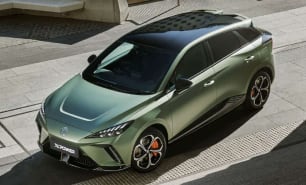As with the exterior, there’s not a lot to differentiate the XPower from the rest of the line-up. No bright red Civic Type R style interior treatment here. MG has opted to carry over the minimalist design that no doubt contributes to the sharp pricing.
Probably the only notable difference is the seat trim, with the XPower model getting a combination of synthetic leather and suede for a sportier look and feel. But the rest is largely the same, which detracts slightly from its hot hatch credentials.
On the plus side, the MG4 cabin is generally a well-designed interior space, which is a positive for the XPower’s hot hatch argument, as the idea behind the ‘hot hatch’ is that it can be a practical car during the week and fun on the weekends.
There’s good room for passengers and luggage, in large part thanks to the relatively slim battery design that frees up more cabin space. Front seat occupants will enjoy the space and good visibility on offer.
Small item storage is very good in the MG4, with a pair of cupholders, a large, flat lidded tray (with one USB-C and one USB-A outlet just above) and the centre console box all fitting between the front seats.
There’s also a wireless smartphone charging pad that sits halfway up the centre fascia, next to the rotary gear selector, but it’s a shallow space so your phone will almost certainly fly out as soon as you begin cornering vigorously.
However, once again highlighting the ways MG has saved money to keep costs down, the back seat accommodation isn’t anywhere near as well appointed.
While the space is adequate for a small hatch, there are no cupholders, no air-conditioning vents and no fold down armrest for those in the back. All they have access to are some pockets on the back of the front seats, including a pair of small ones high on the seat, seemingly designed to accommodate your smartphone.
In another positive for its hot hatch practicality, there are ISOFIX points on the outer rear seats, neatly covered by leather pieces for a cleaner look when you don’t have kids.
As for the boot, the XPower measures the same 363 litres with the seats up which is unchanged from the rest of the MG4 line-up.
Disappointingly, there’s no obvious place to stow the charging cable, even though it comes in a small, neat bag. This is a worryingly common trend with these early generation EVs that shows a lack of practical thinking from the designers.
The MG4 has no under-bonnet storage either, so it feels like a few wasted opportunities for what is a bespoke EV design.

